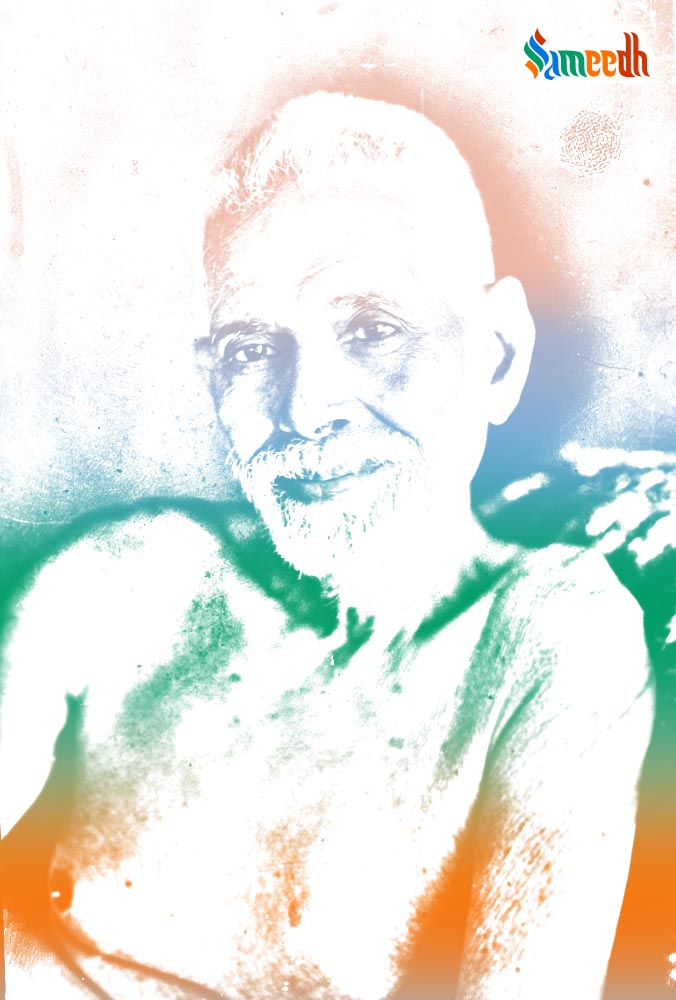Ramana Maharishi is remembered as a liberated soul of the modern times. Why? What were his teachings?

Indian mystic Ramana Maharshi (1879-1950); Image Source: G. G. Welling
BACKGROUND
Ramana Maharshi was an Indian Hindu sage and liberated being of the modern times. He was born Venkataraman Iyer, but is mostly known by the name Sri Ramana Maharshi. In the later years as an ashram grew up around him, visitors received upadesh by sitting silently in his company asking questions.
LIFE
Ramana Maharshi was born Venkataraman Iyer on 30 December 1879 in the village Tiruchuzhi near Aruppukkottai, Virudhunagar District in Tamil Nadu, South India. He was the second of four children in an orthodox Hindu Brahmin family. His father Sundaram Iyer was a court pleader and his mother Azhagammal was a housewife. He had two brothers, along with a younger sister.
Knowing his family would not permit him to become a sanyasi and leave home, Venkataraman boarded the train on 29 August 1896 and reached Tiruvannamalai on 1 September 1896. When the Maharshi arrived in Tiruvannamalai, he went to the temple of Arunachaleswara. He remained in Tiruvannamalai for the rest of his life.
Ramana Maharshi lived in Sri Ramanasramam, the ashram that developed around his mother’s tomb. Sri Ramanasramam grew to include a library, hospital, post-office and many other facilities. Ramana Maharshi displayed a natural talent for planning building projects.
Sri Ramana Maharshi led a modest and renunciate life. From the period when an Ashram began to rise around him after his mother arrived, until his later years when his health failed, Ramana Maharshi was actually quite active in Ashram activities such as cooking and stitching leaf plates.
In the end of 1948, a tiny cancerous lump was found on Ramana Maharshi’s arm and was removed by the ashram’s doctor. The doctor told Ramana Maharshi that a complete amputation of the arm to the shoulder was required to save his life, but he refused. More operations were performed, but they only weakened him. To the devotees who begged him to cure himself for the sake of his followers, Ramana Maharshi is said to have replied, “Why are you so attached to this body? Let it go”, and “Where can I go? I am here.” He succumbed to cancer on 14 April 1950.
WORKS
In 1902, a government official visited the Swami in the hope of obtaining answers to questions about ‘How to know one’s true identity’. Ramana Maharishi’s answers were his first teachings on Self-enquiry, the method for which he became widely known, and were eventually published as ‘Nan Yar’, which translates to, ‘Who am I’.
He composed The Five Hymns to Arunachala in devotional lyric poetry. The first hymn is called as ‘Akshara Mana Malai’ which literally translates to ‘The Marital Garland’, composed in Tamil. It recounts in glowing symbolism the love and union between the human soul and God, expressing the attitude of the soul that still aspires.
CONTRIBUTION IN SOCIETY
Everything that one needs to know spiritually is already expounded in our Vedas and scriptures. Like many others, Maharshi Ramana realised the true self. It is like a river merging with the ocean and becoming the ocean. Ramana Maharshi approved a number of paths and practices, but recommended self-enquiry as the principal means to remove ignorance and abide in self-awareness, together with bhakti or surrender to the self.
AREA OF INFLUENCE
In 1931 a biography of Ramana Maharshi, ‘Self Realisation: The Life and Teachings of Ramana Maharshi’, written by B. V. Narasimha, was published. Ramana Maharshi then became relatively well known in and out of India after 1934 when Paul Brunton, having first visited Ramana Maharshi in January 1931, published the book ‘A Search in Secret India’. His visitors included many great sages and famous figures including Swami Ramdas, Paramhansa Yogananda, Somerset Maugham, Henri Cariet Bresson, Mercedes de Acosta and Arthur Osborne, the last of whom was the first editor of Mountain Path in 1964, the magazine published by ‘Ramanasramam’.
To know more about Hinduism, its Vedic belief system, vedic lifestyle practices, etc. or to replenish your requirements of vedic pooja samagri, or to learn vedic practice systems like yoga, pranayam, etc. please visit our website Sameedh.